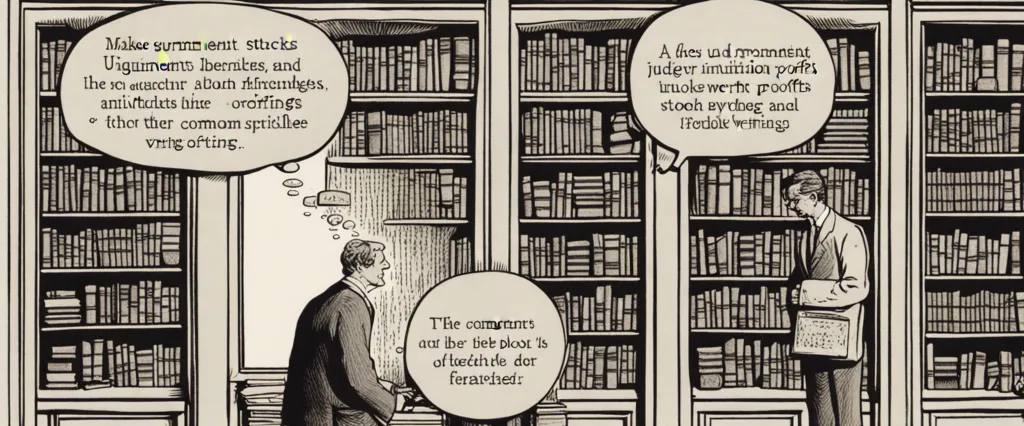In “Finding Your Element,” Ken Robinson explores the concept of personal fulfillment and presents a compelling argument that each individual possesses a unique talent or passion that, when discovered and nurtured, leads to a meaningful and fulfilling life. A renowned expert in the field of education and creativity, Robinson has captivated audiences worldwide with his TED Talks and bestselling books. With his unparalleled expertise, Robinson empowers readers to break free from societal expectations and embark on a journey of self-discovery, ultimately finding their true passions and unlocking their full potential.
Chapter 1: Discovering Your Talents
Chapter 1: Discovering Your Talents in the book “Finding Your Element” by Ken Robinson explores the concept of personal talents and how they can shape our paths to finding fulfillment and success in life.
Robinson begins by emphasizing that every individual possesses unique talents and abilities; however, many people go through life without fully recognizing or utilizing them. He argues that this discrepancy arises from a lack of understanding regarding talents and how they can be discovered.
The chapter delves into the importance of self-awareness in identifying one’s talents. Robinson believes that to discover your element, or the intersection of your passions and natural aptitudes, you must first understand yourself. This understanding encompasses recognizing one’s strengths, weaknesses, interests, and personal inclinations.
He emphasizes the need to broaden our definitions of intelligence, as conventional education often focuses solely on academic intelligence, neglecting other aspects such as creativity, physical abilities, social skills, and emotional intelligence. By recognizing and valuing diverse forms of intelligence, individuals can uncover their latent talents and unlock their true potential.
Robinson provides various examples of individuals who have found their element by embracing their unique abilities. He shares inspiring stories of artists, scientists, athletes, entrepreneurs, and other professionals who have pursued their passions wholeheartedly, leading to exceptional success and satisfaction in their lives.
The chapter also introduces the concept of “tribal traditions” that can impede talent discovery, referring to societal expectations and cultural pressures that may discourage individuals from pursuing unconventional paths. Robinson encourages readers to break free from these constraints and seek out environments where their talents can thrive.
In conclusion, Chapter 1 emphasizes the fundamental role of self-awareness, diverse forms of intelligence, and perseverance in discovering and nurturing one’s talents. By embracing our individual strengths and passions, we can embark on a journey towards finding our element and ultimately leading fulfilling lives.
Chapter 2: Nurturing Creativity
Chapter 2 of the book “Finding Your Element” by Ken Robinson focuses on nurturing creativity and encourages readers to embrace their creative potential. Robinson introduces the concept of “all of us being born with vast reserves of creativity.” He emphasizes that creativity is not limited to artistic or musical skills, but rather a mindset that can be applied to various aspects of life.
The chapter starts by addressing the education system’s role in nurturing creativity. Robinson argues that traditional education tends to prioritize academic subjects, leaving little room for creative exploration. However, he highlights the importance of fostering creativity from an early age, as it is a fundamental aspect of human development.
Additionally, Robinson suggests ways in which individuals can cultivate and nurture their creativity. He emphasizes the significance of finding our passions, as this fuels our creative endeavors. Robinson encourages readers to pursue activities that engage and excite them, and to surround themselves with people who support and inspire their creative journeys.
The chapter also explores the concept of “flow,” which refers to the state of being fully immersed in an activity, feeling energized and fulfilled. Robinson asserts that cultivating creativity requires finding activities that bring about this state of flow, as it allows individuals to unlock their true potential.
Robinson concludes the chapter by underscoring the notion that creativity is not limited to a select few, but is a universal human characteristic waiting to be nurtured. He encourages readers to embrace their creative strengths and invest time and energy in discovering new ways to express their unique perspectives.
In summary, Chapter 2 of “Finding Your Element” advocates for the nurturing of creativity and highlights the need for a broader understanding of creativity beyond traditional artistic fields. It emphasizes the role of education, personal passions, supportive environments, and the state of flow in fostering and maximizing creative potential.
Chapter 3: The Challenges of Education
Chapter 3: The Challenges of Education in the book Finding Your Element by Ken Robinson examines the shortcomings and obstacles prevalent within the education system. Robinson asserts that the traditional education model does not effectively cater to the needs and potential of every individual.
The chapter starts by discussing the prevailing focus on standardized testing, which places heavy emphasis on academic subjects and neglects other areas of talent and skill. Robinson argues that this narrow definition of intelligence hampers the development of individuals who possess various talents and abilities outside the realm of traditional academic subjects, such as arts, sports, or entrepreneurial skills. He urges for a more holistic approach to education that recognizes and nurtures diverse talents.
The author also addresses the issue of creativity and its diminishing presence in formal education. Robinson believes that creativity is an essential skill that is often stifled by the existing education system. Standardized curricula and rigid structures undermine the natural creative potential of students, thus hindering their ability to find their element – the intersection of their passion, aptitude, and purpose.
Furthermore, Robinson emphasizes the significance of personalized education. He stresses the importance of tailoring teaching methods to individuals rather than adopting a one-size-fits-all approach. Recognizing that everyone learns differently, he argues for the need to focus on individual strengths and interests, providing students with a range of opportunities for exploration and self-discovery.
In conclusion, Chapter 3 highlights the challenges faced within education systems worldwide, particularly the limitations of standardized testing, the decline in creative teaching methods, and the lack of personalization. Robinson emphasizes the need for a more inclusive and flexible education system that embraces diverse talents and nurtures creativity to help individuals find their element and unlock their full potential.
Chapter 4: The Power of Innovation

Chapter 4: The Power of Innovation of the book “Finding Your Element” by Ken Robinson explores the concept of innovation and its importance in discovering and nurturing one’s true talents and passions.
Robinson begins the chapter by emphasizing the significance of innovation in today’s rapidly changing world. He stresses that individuals who can think creatively and come up with fresh ideas are more likely to find success and fulfillment in their lives. Innovation requires a certain level of openness, curiosity, and the willingness to take risks.
The author also addresses the common misconception that only certain individuals possess the ability to innovate, suggesting that everyone has the potential to be innovative. He argues that innovation is a skill that can be developed and nurtured through various practices and mindsets.
One key aspect discussed in the chapter is the idea of combining diverse knowledge and skills to generate new ideas. Robinson believes that true innovation often comes from the collaboration of different disciplines, as it allows for a more holistic and dynamic approach to problem-solving.
Furthermore, he emphasizes the importance of creating an environment that fosters innovation, whether it be in schools, workplaces, or personal spaces. This includes creating a culture of experimentation and encouraging individuals to explore and embrace their unique strengths and interests.
Robinson also provides practical advice on how to cultivate innovation, such as seeking inspiration from different sources, maintaining a positive and open mindset, and developing an awareness of one’s own creative process.
In conclusion, Chapter 4: The Power of Innovation underscores the significance of innovation in discovering one’s true element. It promotes the idea that everyone has the potential to be innovative and encourages individuals to embrace their creativity and pursue their passions. By cultivating a mindset of innovation and creating environments that nurture creativity, individuals are more likely to find their own unique path to fulfillment and success.
Chapter 5: Finding Your Passion
Chapter 5: Finding Your Passion of the book “Finding Your Element” by Ken Robinson focuses on helping individuals identify their passions and interests. Robinson begins by highlighting the importance of finding one’s passion, as it leads to a sense of fulfillment and personal growth.
The chapter emphasizes that passion can be discovered through exploration and experimentation. It encourages readers to try various activities and hobbies to gauge their interest and intrigue. By exploring different avenues, individuals can uncover hidden talents and develop a deeper understanding of what truly excites them.
Robinson argues that society often limits people’s exploration of their passions by placing unnecessary pressure on specialization and adherence to traditional career paths. He stresses the need to break free from these constraints and urges readers to embrace their unique interests and pursue them relentlessly.
Moreover, the chapter stresses the role of curiosity in finding one’s passion. Robinson explains that being curious allows individuals to remain open to new experiences, enabling the discovery of new interests and talents. He encourages readers to ask questions, seek new knowledge, and engage in diverse activities to fuel their curiosity and expand their horizons.
Additionally, Robinson emphasizes the importance of seeking out mentors and like-minded individuals who share similar passions. These individuals can provide guidance, support, and inspiration in the pursuit of one’s passion.
In conclusion, Chapter 5 of “Finding Your Element” provides practical advice on how to find one’s passion. It highlights the significance of exploring different avenues, embracing curiosity, breaking societal constraints, and seeking mentors. By following these principles, individuals can discover their true passions and lead more fulfilling lives.
Chapter 6: Personal Growth and Development
Chapter 6: Personal Growth and Development of the book “Finding Your Element” by Ken Robinson explores the significance of personal growth and development in discovering one’s true passion and purpose. Robinson emphasizes that personal growth is an ongoing process, and finding one’s element requires constant introspection and self-reflection.
The chapter discusses the various factors that hinder personal growth and prevent individuals from unearthing their true potential. Robinson highlights the influence of societal norms, educational systems, and societal expectations that often restrict individuals’ exploration of their passions. He stresses the importance of breaking free from these limitations, encouraging readers to embrace their unique talents, interests, and abilities.
Robinson asserts that personal growth is fostered through a combination of self-awareness and experimentation. He argues that understanding oneself is crucial for discovering what truly ignites one’s spirit and propels personal growth. By paying attention to their strengths, weaknesses, and passions, individuals can identify what truly motivates and satisfies them. Additionally, trying new experiences and stepping out of one’s comfort zone is fundamental to personal growth, enabling individuals to expand their horizons and discover new interests.
The chapter also highlights the significance of mentors and role models in personal development. Robinson suggests seeking guidance from those who inspire and support one’s interests, as they can provide valuable insights and motivation throughout the journey of self-discovery. Furthermore, the author encourages readers to surround themselves with like-minded individuals who encourage and inspire personal growth.
In conclusion, Chapter 6 emphasizes the continuous process of personal growth and development as a means to finding one’s element. Through self-awareness, experimentation, and seeking guidance, individuals can break free from societal constraints and discover their true passions, ultimately leading to a more fulfilling and purposeful life.
Chapter 7: Social and Vocational Influences
Chapter 7 of “Finding Your Element” by Ken Robinson explores the social and vocational influences on our search for our true passions and talents. Robinson emphasizes the significant impact that society’s expectations and norms have on individuals’ career paths and personal fulfillment.
Robinson begins by discussing the influence of education on our vocational choices. He argues that traditional education systems often prioritize academic and intellectual achievements, neglecting other talents and skills. This exclusive focus leads many individuals to pursue careers based on societal expectations rather than their true passions. Robinson believes that a more holistic and personalized approach to education is crucial in uncovering and nurturing individuals’ unique talents and interests.
Furthermore, societal pressure often determines what is considered a “successful” career. Many people feel the need to follow conventional paths, pursuing jobs that promise financial stability and prestige, even if they do not align with their true passion. Robinson urges readers to break free from these societal norms and explore unconventional career options that truly resonate with their natural abilities and passions.
Moreover, Robinson explores the impact of familial and cultural influences on our career choices. He emphasizes the importance of open communication and understanding among family members to create an environment that supports individual growth and exploration. Additionally, he addresses the cultural biases that exist in certain societies, which can limit individuals’ potential by enforcing specific vocational roles based on gender, race, or socioeconomic backgrounds.
In order to overcome societal and vocational influences, Robinson suggests practicing self-awareness and actively seeking out opportunities to explore our passions, talents, and aspirations. He encourages readers to surround themselves with supportive and like-minded individuals who believe in their potential. Ultimately, Robinson emphasizes the importance of building a life and career that align with our personal passions and values, rather than conforming to external expectations.

Chapter 8: Unlocking Your Potential
Chapter 8 of “Finding Your Element” by Ken Robinson focuses on unlocking one’s potential. The chapter delves into the various factors that contribute to personal development and the steps individuals can take to tap into their potential.
Robinson emphasizes the significance of personal growth and lifelong learning. He argues that our potential is not fixed but rather can be expanded through continuous learning and self-improvement. He suggests that people should seize every opportunity to acquire new skills, knowledge, and experiences to unlock their hidden talents.
The author also highlights the importance of passion and finding one’s true calling. Many people go through life without ever discovering their passions, which limits their potential. Robinson encourages readers to explore their interests, try new things, and pay attention to activities that bring them joy and fulfillment. By aligning these passions with our abilities and skills, we can unlock our potential and find our element.
Furthermore, the chapter explores the role of mentors and the power of guidance in personal growth. Robinson suggests seeking out mentors who can provide advice, support, and encouragement. Mentors can help individuals discover their strengths, challenge their limiting beliefs, and provide guidance on reaching their full potential.
Additionally, Robinson discusses the impact of environment on personal development. He emphasizes the significance of surrounding oneself with the right people, places, and experiences. Creating an environment that is conducive to personal growth can foster motivation, inspiration, and opportunity for unlocking one’s potential.
In summary, Chapter 8 of “Finding Your Element” emphasizes the importance of continuous learning, finding passion, seeking mentorship, and crafting a supportive environment. By embracing these concepts and taking action, individuals can unlock their full potential and discover their true element.
After Reading
In conclusion, “Finding Your Element” by Ken Robinson offers valuable insights and practical guidelines for individuals seeking to discover and harness their true passions and talents. Through his engaging anecdotes, Robinson emphasizes the importance of self-reflection, perseverance, and taking risks in the pursuit of finding our unique “element.” By recognizing the societal influences that often hinder our exploration of personal interests and creative abilities, Robinson provides strategies to overcome these barriers and embrace our true potential. In this book, he reminds us that finding our element is not an easy journey but a rewarding one, leading to a more fulfilled and purpose-driven life. Overall, “Finding Your Element” is an inspiring and transformative read, encouraging readers to uncover their passions and unleash their full creative potential.
1. “Big Magic: Creative Living Beyond Fear” by Elizabeth Gilbert: In this inspiring book, Elizabeth Gilbert shares her wisdom on how to embrace curiosity and overcome fear in order to unlock your creative potential and find your true passion in life.
2. The Power of Now” by Eckhart Tolle: This bestselling spiritual guide explores the concept of living in the present moment and finding inner peace. By practicing mindfulness and letting go of past regrets and future anxieties, you can discover your true purpose and find fulfillment.
3. The Four Agreements: A Practical Guide to Personal Freedom” by Don Miguel Ruiz: Don Miguel Ruiz presents four principles for personal growth and self-discovery. Through these agreements, you can learn to live authentically, break free from self-limiting beliefs, and connect with your inner wisdom.
4. The Alchemist” by Paulo Coelho: This enchanting novel follows the journey of a young shepherd who seeks his personal legend, or true purpose in life. Through magical encounters and profound wisdom, Coelho’s story reminds us to follow our dreams and listen to our hearts.
5. Mindset: The New Psychology of Success” by Carol S. Dweck: Carol Dweck explores the power of our mindset and how it influences our ability to achieve success and personal growth. By adopting a growth mindset and embracing challenges, you can unlock your potential, overcome obstacles, and find your true passion and purpose.




